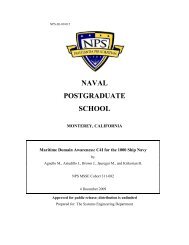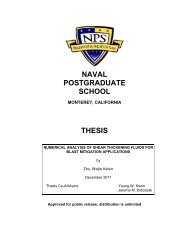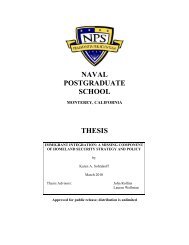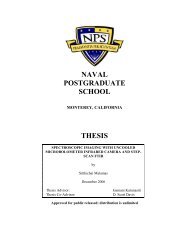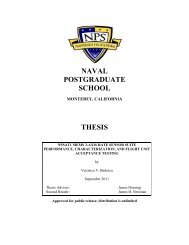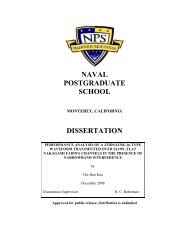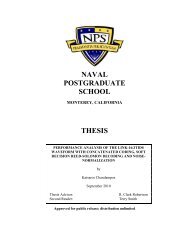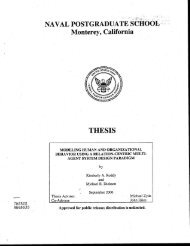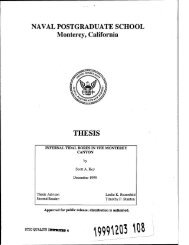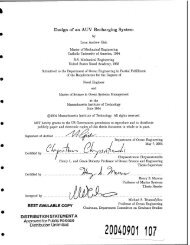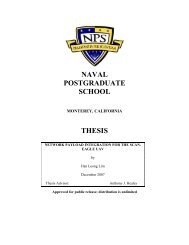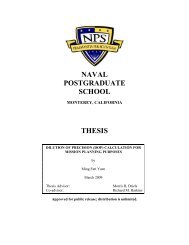A Solution to the Inherent List on Nimitz Class Aircraft Carriers
A Solution to the Inherent List on Nimitz Class Aircraft Carriers
A Solution to the Inherent List on Nimitz Class Aircraft Carriers
Create successful ePaper yourself
Turn your PDF publications into a flip-book with our unique Google optimized e-Paper software.
this pressure. This resulted in a reducti<strong>on</strong> of approximately 55 I<str<strong>on</strong>g>to</str<strong>on</strong>g>ns of ballast, for this particular<br />
case <strong>on</strong>ly. Similarly, <str<strong>on</strong>g>the</str<strong>on</strong>g> <strong>on</strong>ly structural analysis performed for <str<strong>on</strong>g>the</str<strong>on</strong>g> 4* deck void was <strong>on</strong> its deck<br />
plating. Once it was determined that deck stiffening would be required, <str<strong>on</strong>g>the</str<strong>on</strong>g> 4* deck tanks were<br />
taken out of c<strong>on</strong>siderati<strong>on</strong> as a possible locati<strong>on</strong> for placing this ballast. Although adding a<br />
stiffener down <str<strong>on</strong>g>the</str<strong>on</strong>g> middle of <str<strong>on</strong>g>the</str<strong>on</strong>g> deck plating would alleviate any structural c<strong>on</strong>cerns, welding <str<strong>on</strong>g>to</str<strong>on</strong>g><br />
<str<strong>on</strong>g>the</str<strong>on</strong>g> deck plating would have <str<strong>on</strong>g>to</str<strong>on</strong>g> be performed. With welding required <strong>on</strong> <str<strong>on</strong>g>the</str<strong>on</strong>g> bot<str<strong>on</strong>g>to</str<strong>on</strong>g>m deck plating,<br />
a watch would need <str<strong>on</strong>g>to</str<strong>on</strong>g> be stati<strong>on</strong>ed <strong>on</strong> <str<strong>on</strong>g>the</str<strong>on</strong>g> o<str<strong>on</strong>g>the</str<strong>on</strong>g>r side of <str<strong>on</strong>g>the</str<strong>on</strong>g> deck. The tanks below <str<strong>on</strong>g>the</str<strong>on</strong>g>se 4 deck<br />
tanks are foam filled and a fire watch cannot be stati<strong>on</strong>ed in <str<strong>on</strong>g>the</str<strong>on</strong>g>se tanks.<br />
Once a maximum pressure in head of water was calculated, <str<strong>on</strong>g>the</str<strong>on</strong>g> breadth-thickness ratio<br />
formula could be used again <str<strong>on</strong>g>to</str<strong>on</strong>g> determine <str<strong>on</strong>g>the</str<strong>on</strong>g> stiffener spacing or limiting short dimensi<strong>on</strong> of <str<strong>on</strong>g>the</str<strong>on</strong>g><br />
panel. If <str<strong>on</strong>g>the</str<strong>on</strong>g> calculated maximum distance that <str<strong>on</strong>g>the</str<strong>on</strong>g> stiffeners can be located apart fell less than<br />
<str<strong>on</strong>g>the</str<strong>on</strong>g> actual stiffener spacing, <str<strong>on</strong>g>the</str<strong>on</strong>g>n no plastic deformati<strong>on</strong> would occur and stiffening of <str<strong>on</strong>g>the</str<strong>on</strong>g> plating<br />
was not required. If stiffening was required, <str<strong>on</strong>g>the</str<strong>on</strong>g>n <str<strong>on</strong>g>the</str<strong>on</strong>g> panel thickness was usually divided in half<br />
<str<strong>on</strong>g>to</str<strong>on</strong>g> accommodate <str<strong>on</strong>g>the</str<strong>on</strong>g> calculated pressure.<br />
The final calculati<strong>on</strong>s involved verifying that <str<strong>on</strong>g>the</str<strong>on</strong>g> calculated maximum allowable stress<br />
was less than <str<strong>on</strong>g>the</str<strong>on</strong>g> design allowable stress for <str<strong>on</strong>g>the</str<strong>on</strong>g> particular type of steel, regardless of whe<str<strong>on</strong>g>the</str<strong>on</strong>g>r<br />
any modificati<strong>on</strong>s were made. The basic equati<strong>on</strong> used <str<strong>on</strong>g>to</str<strong>on</strong>g> calculate <str<strong>on</strong>g>the</str<strong>on</strong>g> maximum stress<br />
governing <str<strong>on</strong>g>the</str<strong>on</strong>g> behavior of plating under lateral load, or plate bending, can be seen below.<br />
Using small deflecti<strong>on</strong> <str<strong>on</strong>g>the</str<strong>on</strong>g>ory, <str<strong>on</strong>g>the</str<strong>on</strong>g> value of <str<strong>on</strong>g>the</str<strong>on</strong>g> coefficient k depends <strong>on</strong> <str<strong>on</strong>g>the</str<strong>on</strong>g> boundary<br />
c<strong>on</strong>diti<strong>on</strong>s. For simply supported edges, k=.75 and for clamped edges, k=.5. Simply supported<br />
and clamped structural cases are idealizati<strong>on</strong>s of structural member support illustrating zero<br />
stiffness and infinite stiffness, nei<str<strong>on</strong>g>the</str<strong>on</strong>g>r of which exists in any real-world structural system. On<br />
37



